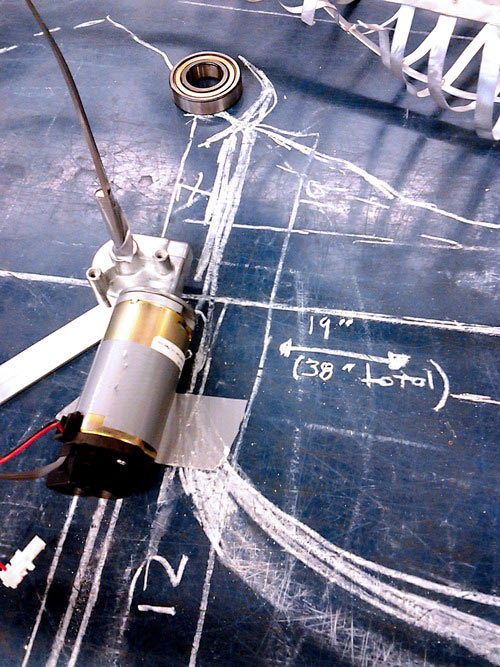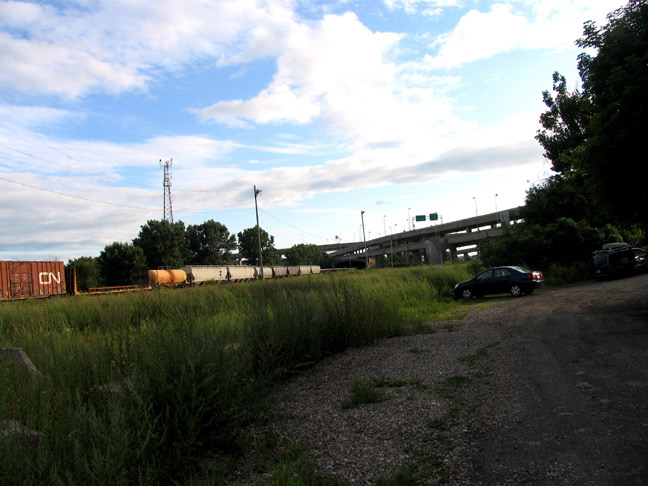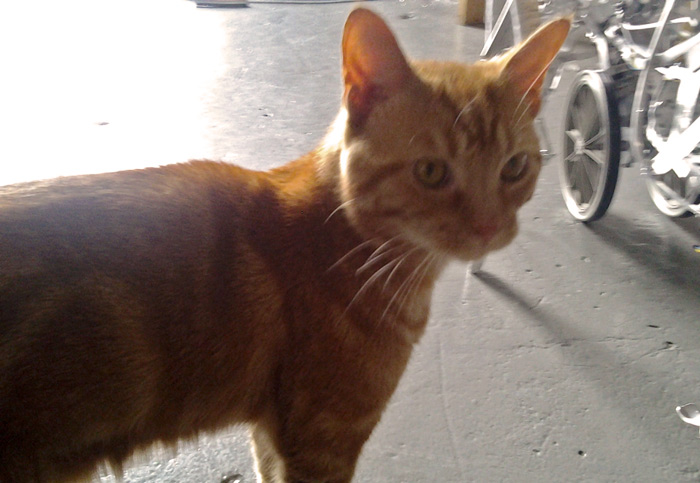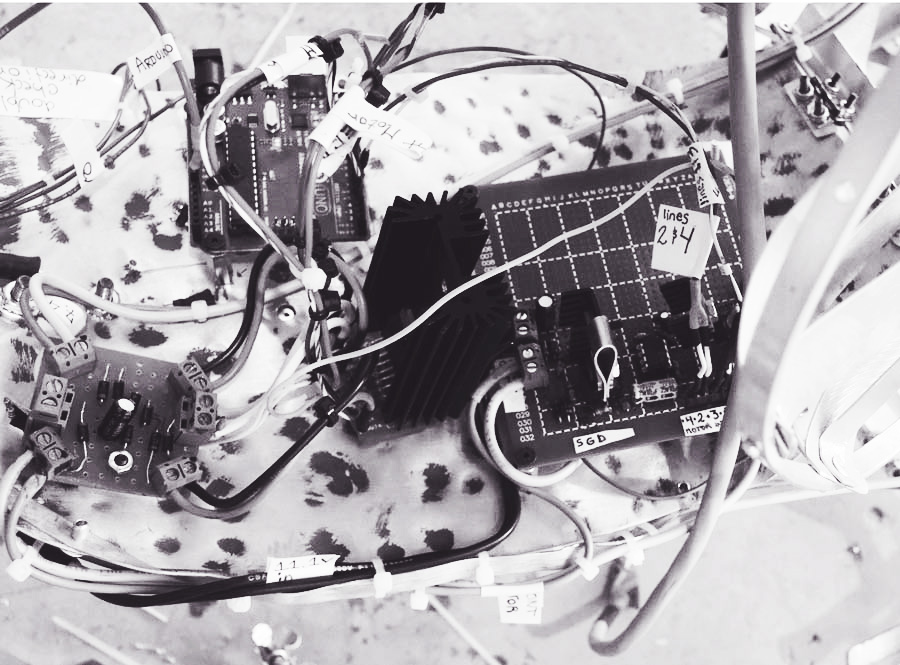 My grandfather, a Universidad Técnica mathematics professor, later also tutored rich dumb children in a small room with a blackboard at the back of the house. Before I even learned how to read and write I would peek during his lessons watching him scribble symbols on the blackboard in dazed fascination.
My grandfather, a Universidad Técnica mathematics professor, later also tutored rich dumb children in a small room with a blackboard at the back of the house. Before I even learned how to read and write I would peek during his lessons watching him scribble symbols on the blackboard in dazed fascination.
In the same way that I couldn't imagine ever getting tall enough to look down at the bathroom sink, I couldn't quite imagine a time when I could spend hours playing with the mysterious symbols on the board. Getting taller just sort of happened but, I never managed to wrap my head around the language of numbers.
Outside my family I never encountered teachers who seemed to care about math themselves. In Junior High my math teacher's usual job was that of phys. ed. coach. Over the years, when I asked what this was all in aid of, I was bluntly told by several teachers, that there really is no point to math now that we had computers and calculators, you do math to prove that you can do something pointless, that you have discipline – the mental equivalent of running laps around the field.
My parents were at the other extreme, life-long delighted enthusiasts. My mother trained as an inorganic chemist and looved math, doing problems the way others do crosswords. My father was a chemical engineer. Reality, my mother said, could only be understood mathematically. She would look at the model of the atom we used in class with disbelieving contempt, and go on at length about the structural nothingness of the kitchen table.
I felt the honesty of their enthusiasm, the only thing they had in common, but I honestly never had a clue what they were talking about. I learned never to ask for help with my homework because my mother always wanted to show me at least four different ways to do things while all I wanted was to end it as soon as possible.
Like most illiterates, I cunningly worked my way in circles to cover up my ignorance.
But I can remember the exact moment when the point of it finally clicked. I was wandering through Munro's books in Victoria when I picked up a book on the life of Tycho Brahe, the brilliant rich mathematical weirdo with the fake nose. I read how Johannes Kepler used his astronomical observations to work out that the planets had elliptical orbits, leading to another absolute tear in the medieval belief of the perfect harmony of spheres. Reality connected to abstraction.
I was actually shocked. No one had ever brought up something like this. It had nothing to do with taxes or the non-existence of physical reality. I wish I could remember the name of the book. Not long after I found out about Eratosthenes figuring out the circumference of the earth quite accurately by comparing the angle of the sun's rays in two different towns at the same time. And, trying to understand what integral calculus was all about, I realized, finally, decades too late, what a swooping and fantastical thing mathematics could be. They could simply define the mysterious unknowns in a situation, call them 'x' and then work with everything they did know. Its logic can describe the tactile world, or it can wander off to imaginary realms.
But I've never gotten anywhere near any of that. I didn't learn to add and substract till I had to work a cash register. I've never learned to multiply and divide. If it wasn't for online calculators I wouldn't be able to work out the circumference of a circle, area, weights, fractions, nothing.
Knowing nothing, when I started trying to build robots I had to start with the children's books, The New Way things Work by David Macaulay and Neil Ardley was my favorite. And I finally recognized my endless hunger for getting at how a system is put together, magnetism, gears, and what makes motion possible. How to make things move.
But this was also the moment when I thought I could leave aside calculations and theorems and work blind with whatever surplus materials I could afford to get my hands on. Continue reading "Force and numerical illiteracy"
 Trying to build the blob 'robot' has shown me this better than anything. And I don't want to abandon the Blob, but I'm far from getting it working the way that I want.
I'm in love with the idea of building a robot that's big, super-light, semi-autonomous. I want a slow-moving beast that can wander the urban landscape.
I showed the latest version of the blob at the Eastern Bloc here in Montreal as part of the Robotis Personae exhibition, January 22-February 11, 2015. I decided to hang the blob from the ceiling instead of trying to make it move around. That in itself was a huge sadness for me.
Trying to build the blob 'robot' has shown me this better than anything. And I don't want to abandon the Blob, but I'm far from getting it working the way that I want.
I'm in love with the idea of building a robot that's big, super-light, semi-autonomous. I want a slow-moving beast that can wander the urban landscape.
I showed the latest version of the blob at the Eastern Bloc here in Montreal as part of the Robotis Personae exhibition, January 22-February 11, 2015. I decided to hang the blob from the ceiling instead of trying to make it move around. That in itself was a huge sadness for me.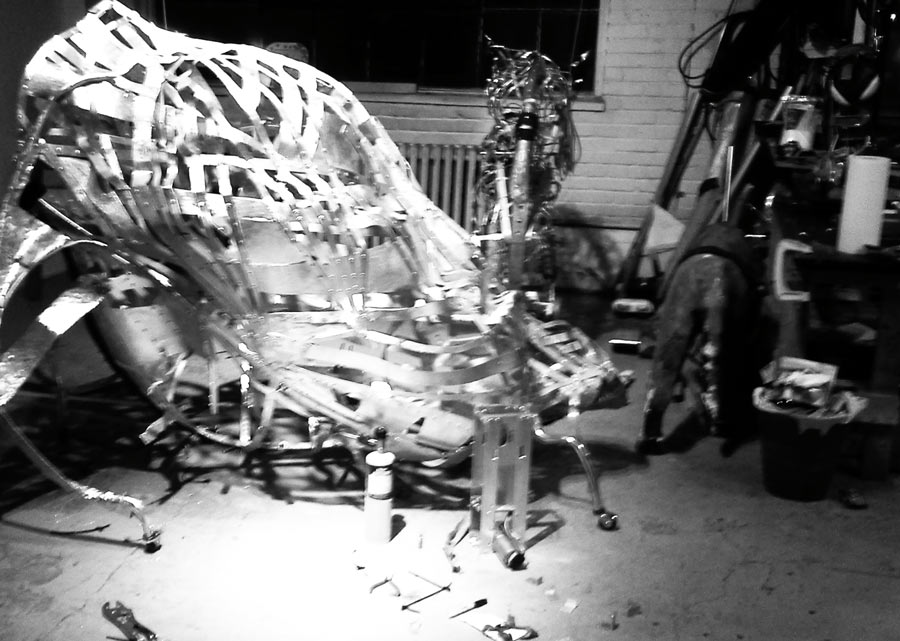 Right now, this is not a robot.
It's a noisy, beautiful and brainless hunk of metal.
I built the original skeleton by riveting sheet aluminum over a frame of heat-bent aluminum channel stock. I wanted to try to build a large, light robot that would bounce awkwardly on misshapen-wheels, forever on the point of tipping over... And this has made everything difficult!
How do you get not-round wheels turning smoothly? How do you keep something on the verge of tipping over from actually tipping over? Right now, the answer is, you don't.
Right now, this is not a robot.
It's a noisy, beautiful and brainless hunk of metal.
I built the original skeleton by riveting sheet aluminum over a frame of heat-bent aluminum channel stock. I wanted to try to build a large, light robot that would bounce awkwardly on misshapen-wheels, forever on the point of tipping over... And this has made everything difficult!
How do you get not-round wheels turning smoothly? How do you keep something on the verge of tipping over from actually tipping over? Right now, the answer is, you don't.



